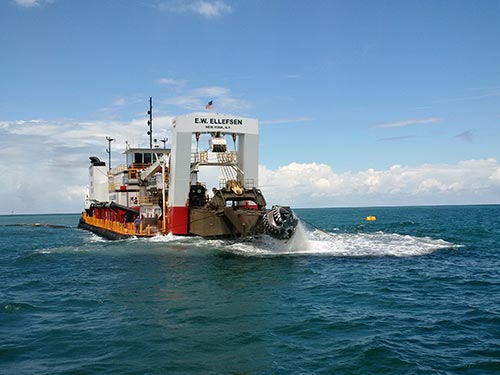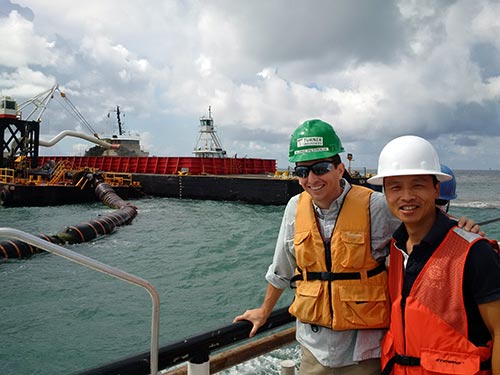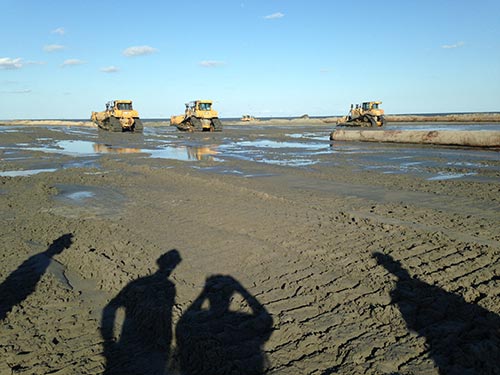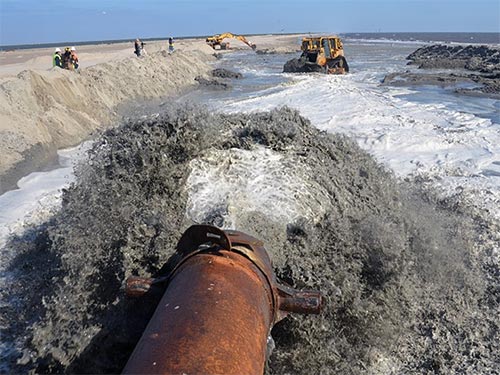Coastal Restoration Economics: A Granular Look at Project Performance
The Key Resource
From the smallest of vegetative plantings to large-scale diversions of the Mississippi River, Louisiana’s coastal restoration efforts all focus directly or indirectly on a single, critical resource – sediment. The capture and retention of sediment is of paramount importance to a coastline that has lost nearly 2,000 square miles of land in the past century, and one expected to lose an additional 4,000 square miles in the next 50 years without sufficient action.

The Cutterhead Dredge E.W. Ellefsen of Weeks Marine on location at Ship Shoal, November 2016 (Photo: Hua Wang)
For this reason, Louisiana’s portfolio of sediment-focused coastal restoration projects is increasing. Among such projects, dedicated dredging has emerged as the largest single category of restoration spending. The Louisiana Coastal Protection and Restoration Authority (CPRA) estimates the cost of its 50-year Coastal Master Plan at $50 billion. Of that amount, $22 billion is slated for projects involving the mechanical extraction and placement of sediment. Most of these projects will play out on the state’s seaward shorelines and barrier islands, where sediment sourcing is largely driven by the availability and cost of sand.
Rethinking Benefits
The economic assessment of coastal dredging has historically centered on project construction, with the largest factor being the costs per unit of sediment used to fill a given restoration template. A recent paper in the Journal of Environmental Management, however, expands on this approach by examining how sediment quality affects the economics of project performance. The paper derives from a three year study sponsored by the Bureau of Ocean Energy Management (BOEM).
The idea for the study originated with Mike Miner, a geologist by training, and since 2018, director of Applied Geoscience for the Water Institute of the Gulf. In a prior life, Miner worked with the Marine Minerals Mining Program at BOEM where he represented the bureau on dozens of barrier restoration projects in Louisiana and the broader Gulf region. According to Miner, it was a period in which the economic realities of project performance were sometimes slow to materialize,
“Geomorphologists had long noted the resiliency advantages of larger diameter sands, but the nearshore availability of smaller grain, lower-cost sediments was often the deciding factor in project sourcing.”
Miner believed that a more formal analysis of project costs versus project performance could be achieved through a combination of physical and economic modeling. For the geomorphic analysis, he recruited Ioannis Georgiou, a coastal engineer at the University of New Orleans (UNO) who would later become the Water Institute’s director of Coastal and Deltaic Systems Modeling. On the economic side, he contacted Rex Caffey, a resource economist with the Louisiana State University (LSU) Agricultural Center and the Louisiana Sea Grant College Program. In turn, Caffey recruited fellow resource economists Hua Wang of LSU and Daniel Petrolia of Mississippi State University. Funding for the study was provided in 2016 by an award administered through the Louisiana State University Coastal Marine Institute.

Economists Daniel Petrolia and Hua Wang observe OCS dredging operations at Ship Shoal, November 2016 (Photo: Rex Caffey)
An Offshore Trip
Year one of the study included numerous meetings at UNO, with the team brainstorming diagrams and terms on a white board. Caffey recounts that period as one with some translation challenges,
“When we first started out, the economists and physical scientists were struggling to understand each other’s language.”
Team communications eventually improved, especially in the wake of a field trip arranged later that year in cooperation with CPRA. The trip was to Ship Shoal, an ancient, submerged delta of the Mississippi River. This elevated area of sandy seafloor on the Outer Continental Shelf (OCS) lies 30 miles offshore of Port Fourchon, Louisiana. The purpose of the trip was to observe a large-scale dredging operation underway at the Shoal in support of the Caminada Headland Beach and Dune Restoration Project. Accompanying the team was Brad Miller, CPRA’s project manager on Caminada.
Miller describes the Caminada project as, “ambitious and very complex.”
The Caminada Headlands project was primarily constructed using a three-stage process of sediment transport. In the first stage, sediment from Ship Shoal was harvested with a large cutterhead dredge and deposited into a series of eight marine transport “scow” barges. In the second stage, each sediment-laden barge was transported by a tugboat across 30 miles of open ocean to a shallow-water relay station located just offshore of the project template. In the final stage, the contents of each barge were mixed with sea water and pumped onshore. Once ashore, the slurry would dewater, with the deposited sediment maneuvered into place using bulldozers. Through this process, nearly seven of the project’s approximately nine million cubic yards of sediment was conveyed, renourishing a 13-mile span of barrier shoreline.

Study team observes sediment working at the Caminada Headlands project, November 2016 (Photo: Hua Wang)
The research team spent that day offshore following the route of a single load of sediment – from filling of the scow barge at Ship Shoal, to 30 miles of oceanic transport, to nearshore staging and onshore pumping. Given the total volume of sediment relayed on Caminada between 2012-2017, it was a route that would play out more than 2,600 times during the project’s two phases of construction. The trip allowed the physical scientists on the team to conduct a field seminar on the mechanics and semantics of OCS dredging. And it allowed team economists to begin formulating the quantitative approach that would be used for measuring cost and performance tradeoffs of coastal dredging projects.
Model Development
In the second year of the project, the team agreed on a conceptual model for the analysis – a simulated nourishment project within a barrier system based on the historical footprint of the Isle Dernieres Island chain. The corresponding numerical model, a variation of Benefit Cost Analysis (BCA), would require the development of separate sub models of project benefits and costs.
The Delft3D software suite was used to create coupled sub models of sediment transport with flow and waves to help determine sediment pathways, including sediment accumulation at the nourishment site and the system level, for both surface and subsurface environments. Cumulative deposition and erosion of sediment was simulated over a 50-year horizon for a no-action scenario, and for a project constructed using nearshore (NS) and OCS sediments of various quality (grain size and fines content). A sub model for project cost was developed using dredging attribute data derived from 93 commercial bids representing 35 NS-sourced and OCS-sourced barrier renourishment projects constructed in coastal Louisiana from 1997-2018.
Study Results
The final year of the project involved integrating the physical and cost sub models into a BCA framework. Team economists had developed a method to estimate the break-even value (BEV) of ecosystem services, that is, that value at which project costs were just offset by project benefits. This metric would be used to evaluate project efficiency and economic tradeoffs associated with sediment quantity, quality and transport distance. Results indicate that even small increments in sand diameter can yield significant economic advantages over long time horizons. Moreover, OCS-sourced projects constructed with much higher quality sands were found to be more cost-effective (lower BEV) than all smaller grained, NS-sourced projects at common cut-to-fill ratios. In some comparisons, the larger grain sizes yielded lower BEVs for projects with transport distances exceeding 30 miles – a finding consistent with sediment sourcing from remote locations like Ship Shoal.

Dredge disposal operations at the Caminada Headland (CPRA photo)
Critics of dedicated dredging, however, often focus on the vulnerability of shoreline renourishment projects to hurricanes – asserting that a multi-million-dollar project can be wiped out overnight by a single storm. To address this issue, a final set of simulations was developed to examine the performance implications of a Category 2 hurricane occurring at two points in the simulated project trajectory. Under storm-punctuated simulations, the advantages of higher quality sands were found to be more pronounced, with greater economic implications for earlier (Year 5) versus later (Year 20) occurring storms. This finding would be somewhat tested in 2021, when Category 4 Hurricane Ida made direct landfall on Caminada Headlands, five years after project construction. While impact surveying by CPRA is ongoing, initial assessments of the project’s post storm condition have been positive.
Program Implications
The evolution of Louisiana’s response to coastal land loss has been one in which the availability and cost of sediment has emerged as the most critical factor. Sediment inventory maps estimate the total volume of Louisiana-adjacent OCS sand at nearly 2.6 billion cubic yards, with 60 percent of this material considered recoverable under current technological and regulatory constraints. Until recently, access to these offshore deposits was considered economically infeasible in comparison to lower quality, proximal sources.
Previous approaches to project budgeting have centered on the value of sediment as a commodity, with a focus on placement cost. The findings of this study, however, appear to provide economic confirmation to the longstanding notion of geomorphologists that “grain-size matters.” At a minimum, the study indicates that a more comprehensive accounting of project performance (beyond construction) is required to maximize the return on coastal restoration spending.
To view the article online, see:
Caffey, R. H., Petrolia, D. R., Georgiou, I. Y., Miner, M. D., Wang, H., & Kime, B. (2022). The economics of sediment quality on barrier shoreline restoration. Journal of Environmental Management, 319, 115730.
